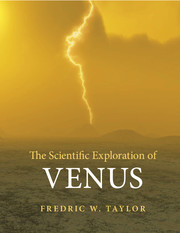Book contents
- Frontmatter
- Contents
- Overview
- Prologue
- A note on scientific units
- Acknowledgements
- Part I Views of Venus, from the beginning to the present day
- Chapter 1 The dawn of Venus exploration
- Chapter 2 Mariner and Venera
- Chapter 3 Pioneer Venus and Vega
- Chapter 4 Images of the surface
- Chapter 5 The forgotten world
- Chapter 6 Earth-based astronomy delivers a breakthrough
- Chapter 7 Can’t stop now
- Chapter 8 Europe and Japan Join In
- Part II The motivation to continue the quest
- Part III Plans and visions for the future
- Epilogue
- References and acknowledgements
- Appendix A Chronology of space missions to Venus
- Appendix B Data about Venus
- Index
- Plate section
- References
Chapter 6 - Earth-based astronomy delivers a breakthrough
from Part I - Views of Venus, from the beginning to the present day
Published online by Cambridge University Press: 05 September 2014
- Frontmatter
- Contents
- Overview
- Prologue
- A note on scientific units
- Acknowledgements
- Part I Views of Venus, from the beginning to the present day
- Chapter 1 The dawn of Venus exploration
- Chapter 2 Mariner and Venera
- Chapter 3 Pioneer Venus and Vega
- Chapter 4 Images of the surface
- Chapter 5 The forgotten world
- Chapter 6 Earth-based astronomy delivers a breakthrough
- Chapter 7 Can’t stop now
- Chapter 8 Europe and Japan Join In
- Part II The motivation to continue the quest
- Part III Plans and visions for the future
- Epilogue
- References and acknowledgements
- Appendix A Chronology of space missions to Venus
- Appendix B Data about Venus
- Index
- Plate section
- References
Summary
In the mid-1980s, Venus exploration by spacecraft received a big boost from what seemed at the time a rather unlikely source: Earth-based telescopes in observatories on mountaintops. This was unexpected because the key discoveries that could be made from 50 million miles away, with our atmosphere in the way, were thought by most of us to be essentially in the past. Close-in polar orbiters, entry probes and landers ruled almost everyone’s thoughts – those who thought about Venus at all – as the twentieth century moved towards a close. The ground-based observers were, in any case, more preoccupied with distant galaxies and cosmology, and nowadays are generally reluctant to devote expensive telescope time to poking around in what they see as their own backyard. Also, of course, there was the usual endless rivalry for funds between planetary and deep-space astrophysicists, and between space scientists and traditional astronomers, to be taken into account.
The breakthrough happened in Australia. Astronomers at the Anglo-Australian telescope in New South Wales had developed a new near-infrared imaging spectrometer optimised for imaging extended objects such as star formation clusters and the nearby planets of the Solar System. Venus was prominent in the sky, with a bright crescent showing and most of the disc dark, when the observers turned the big 3.9-metre aperture telescope in its direction in June 1983. Examining the data, they were surprised to find that the nightside was not in fact dark everywhere in the near infrared spectrum, but instead ghostly bright features were present at a few wavelengths just longer than visible light (Figure 6.1).
- Type
- Chapter
- Information
- The Scientific Exploration of Venus , pp. 75 - 86Publisher: Cambridge University PressPrint publication year: 2014



